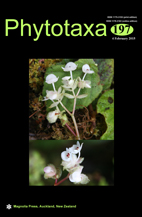Abstract
The freshwater lichens Verrucaria elaeomelaena, V. alpicola, and V. funckii (Verrucariaceae/Ascomycota) have long been confused with V. margacea and V. placida and conclusions on the substratum preference and distribution have been obscured due to misidentifications. Independent phylogenetic analyses of a multigene dataset (RPB1, mtSSU, nuLSU) and an ITS-dataset combined with morphological and ecological characters confirm that the Verrucaria elaeomelaena agg. consists of several cryptic taxa. It includes V. elaeomelaena s.str. with mostly grey to mid-brown thalli and transparent exciple base which cannot be distinguished morphologically from several other unnamed clades from low elevations, the semi-cryptic V. humida spec. nov., which is characterised by smaller perithecia, shorter and more elongated spores compared to other species in this group and V. alpicola with specimens mostly from high elevations, dark brown to black thalli, a brown exciple base and large ascospores. While Verrucaria funckii is confirmed to be restricted to siliceous substrata, limestone and siliceous substrata are both colonised by V. elaeomelaena s.str. as well as by representatives of various other clades. The substratum type cannot be seen as a diagnostic character for taxa within this species group. The taxa included in Verrucaria elaeomelaena agg. are closely related to V. submersella and together with V. funckii they form a sister clade to the “Endocarpon-group” in the Verrucariaceae. Verrucaria margacea is superficially similar to some specimens of V. elaeomelaena agg. It is nested within an unresolved larger clade with Dermatocarpon, the subclades of the Endocarpon- and the V. elaeomelaena-group. Verrucaria margacea can be distinguished from most of the specimens in the V. elaeomelaena group by its generally non subgelatinous thallus, often with distinct cracks, narrowly ellipsoidal ascospores and the general absence of a black basal layer or dark pigments in the exciple base. The form and size of the ascospores distinguish V. placida from most specimens in the V. elaeomelaena complex, but there is overlap with some forms of V. alpicola. Epitypes are proposed for V. elaeomelaena, V. alpicola and V. margacea and a European key to the species of subgelatinous freshwater Verrucaria with spreading involucrellum and large ascospores is provided.

